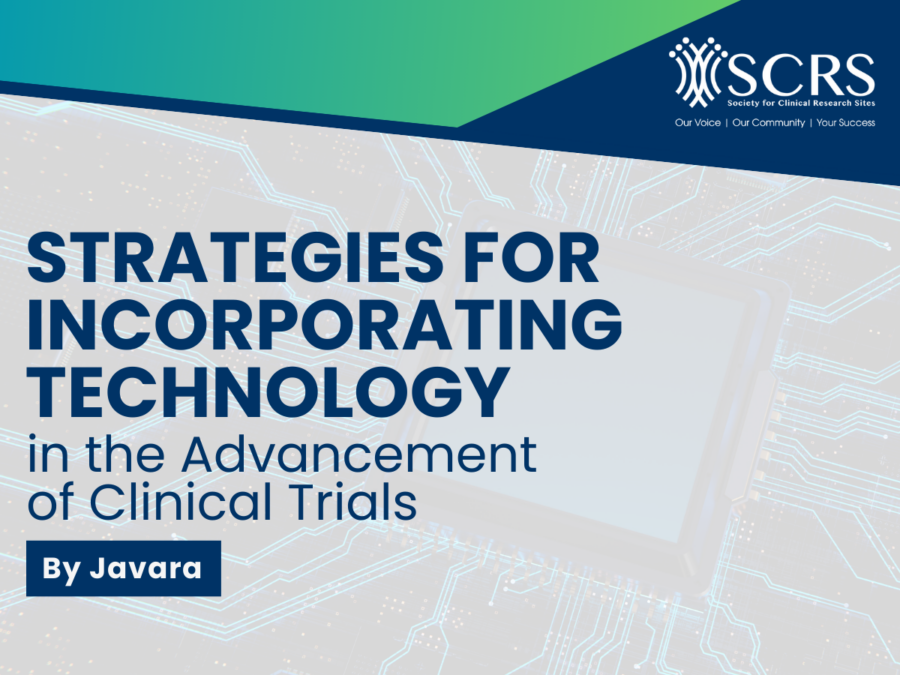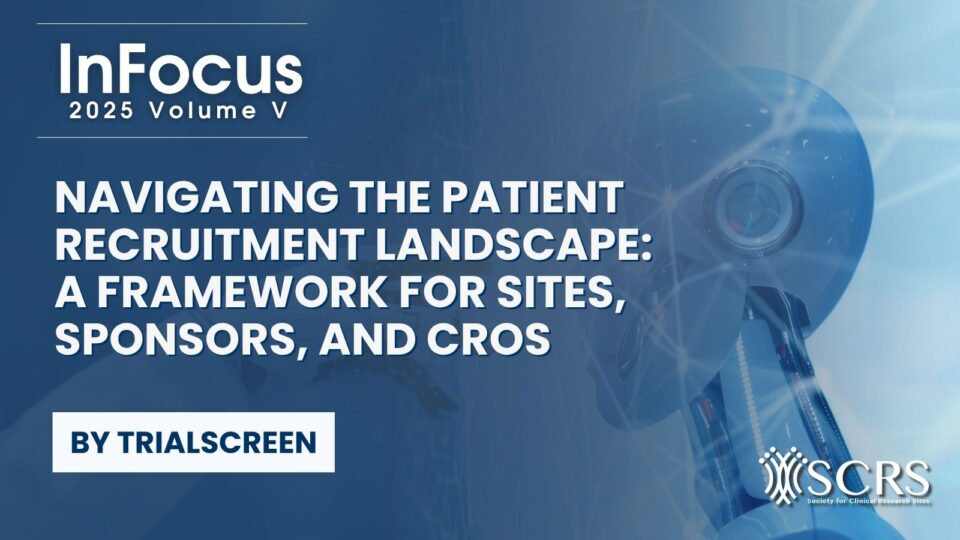Strategies for Incorporating Technology in the Advancement of Clinical Trials

There is an increasing number of digital tools available to us as clinical researchers, as our industry continues to work to streamline the complex process of running clinical trials. These technologies can help us improve efficiency, accuracy, and the participant experience, but our strategies for implementing these resources do matter.
As a site operations lead for an IRO, or Integrated Research Organization (Javara), I am embedded within a health care facility in Savannah, Georgia. Working as an extension of the care teams at this practice, our approach to new technological resources has illuminated a lot of inefficiencies and areas for growth. For example, we have found that just the initial shift from paper to an eSource system leads to significant improvements, such as more rapid identification or anomalous data, and ensuring audit readiness. There are a multitude of additional systems that can be used in tandem with the eSource system, and many are worth incorporating, but it is important to note that just the first step of eSource implementation is impactful to evolve the way in which trials are run.
A multitude of systems
The current trend for technologies in clinical research is integration and interoperability. When systems communicate with each other, it increases data accuracy and improves trial efficiency by streamlining workflows.
At our sites, we are also experienced interacting with the electronic data capture (EDC) systems that are provided by sponsors to all trial locations. The benefit of leveraging these platforms is they aggregate data from various sites, with clear visibility for the sponsor at all times. The system validates data, manages queries, and hosts audit trails allowing sponsors to manage data efficiently and comply with regulatory standards.
The eSource system is the heart of the digital system at the site level. These systems are electronic platforms used to capture data right at the source. Instead of recording data on paper, it can now be entered digitally during participant visits. We use this system both during the trial and also to retain participant information after the study has concluded and the sponsor has removed site access to their systems.
Our eSource system does not currently communicate directly with EDC systems, as it is vital that strong measures be in place for data integrity and security. However, entering data into EDC systems from our eSource system instead of via paper charts alone improves efficiencies greatly.
A variety of other systems do connect with eSource systems, EDC systems or both, some of which we do leverage as well. Examples of other systems integrating with eSource include:
Recruitment platforms, which use data from electronic health records (EHRs) as well as demographic analysis to identify potential participants. These platforms generally integrate with eSource systems to automatically update participant status and share eligibility data.
Scheduling tools, which also integrate with eSource systems and send automated reminders to site staff and participants.
eConsent systems, which provide digital, interactive documents, send signed consent forms to the participants directly. This is also stored for quick accessibility to sites.
Randomization and trial supply management (RTSM) systems, which also can integrate with both eSource and EDC systems, automating participant randomization, drug inventory management, and the allocation and tracking of study treatments across trial sites.
Choosing the right system
As helpful and time effective as these new systems can be, it is important to be diligent in researching each system’s capabilities and limitations to find the tools or technologies that best meet your needs. For example, are you looking for a tool to improve patient recruitment? Or something to speed up data collection and reporting? These questions can be challenging to answer in an environment of rapid advancement, where both current features and future capabilities are important aspects of a comparison and require mindful evaluation.
Additionally, it is crucial to choose a vendor who is willing to listen to your site or company’s needs and real-time feedback from staff. The best vendor partners should take into consideration what research sites say is working, not working, or slowing down processes and adapt.
Another important consideration when evaluating and choosing the right system is sponsor support. It is critical that both that sponsors listen to what sites need from their EDC systems and that sites communicate those needs directly. I have been on many calls with sponsors who were genuine when inquiring what they could do to save time and maximize resources for us at the site level. Sites expressed a desire to have the data they enter into randomization and screening systems automatically transfer into the sponsor’s EDC system, and together, we were able to make that happen. In the past year or two, this has become much more common, and I foresee these collaborative conversations between sites and sponsors on how to improve our technologies and efficiencies will only continue to increase.
Facilitating support for investigators and trial sites
An important part of our job as an integrated research organization is supporting our physician investigators through the process of integrating research into their clinical practice. New technologies have been helpful as part of this process.
For example, electronic signatures have made study start-up faster. Another valuable aspect of these newer systems is automation of notifications and reminders to investigators. Physicians are very busy, and it is important that the process be as simple and clear for them as possible, and task reminders are very beneficial.
Additionally, the more user-friendly the new systems are, the easier the implementation will be. Training is important, of course, and it is wise to conduct a pilot test before a new rollout. Informing staff about the process and the benefits of implementation will increase enthusiasm and commitment. Communication is key when rolling out new technologies or other resources, and helping teams and investigators understand how this new system or platform will improve efficiency, save time and simplify their daily responsibilities also drives buy-in.
I have found that staff generally appreciate the efficiencies of new systems and are eager to see them successfully implemented. We have heard frustration from some physician investigators about the high number of passwords that they must currently juggle when systems are consolidated, concerns of this nature can also be addressed. Technologies ultimately provide critical elements of simplification which empowers all involved.
Technology empowers decentralized studies
The opportunity for decentralized clinical trials has become increasingly common in recent years, and remote monitoring technologies have played a significant role in making this possible. Some of these technologies send real-time data. Others do not transmit in real-time but rather store information that is then downloaded during a patient visit. Both are valuable to site operations.
We recently did our first decentralized study, made possible by telehealth visits, which provided a sizable boost in patient access. Though I believe some face-to-face contact will always be important to build relationships, cultivate trust, and maintain compliance, decentralized studies have large potential to improve the patient experience.
There are many technological advancements that enable decentralized trials, but the adoption of remote devices that communicate smoothly with our other systems has been one of the most impactful. Having systems that patients can utilize and navigate easily is very important for the success of studies. Making sure the systems are user friendly for the participant helps tremendously with the level of compliance achieved as well as how eager a patient is to complete study tasks.
However, having these well-designed platforms tested and in place prior to the site activation is critical so there are no delays with enrollment. Ensuring these systems also enable direct engagement between patient and staff also contributes to retention and compliance within the study because patients are comfortable and trusting of the study team.
Challenges will be part of the process
So far, we have encountered only a few disadvantages when using more advanced technology systems, the primary challenge being usability among older populations. These patients sometimes have trouble navigating eConsent forms on a tablet, and I’ve witnessed a similar problem with eDiaries, which can lead to compliance issues. Regular reminders and additional support may be necessary to ensure these self-reporting platforms are used appropriately without added stress or burden to the patient.
Lack of a reliable internet connection can also pose problems for some patients and certain regions. Here in Savannah, we can occasionally experience extreme weather that slows internet access. For example, we recently had a hurricane that completely cut out connection and prevented us from seeing patients due to lack of access to sponsor systems. Having a paper option on hand in case of events like this is important, but it is not necessary to avoid new technologies out of concern for challenges such as these. The value our electronic systems provide on a regular basis far outweighs the additional preparations needed during unique circumstances.
Conclusion
Advanced technologies at the site level are rapidly changing the way trials are conducted, making them more efficient, accurate and patient-centric. These resources also empower study teams to maximize efficiencies and improve the patient experience. As we continue to acquire new digital systems and platforms in the clinical research space, it is important to understand how these tools can and should be levered to maximize efficiencies that meet your most pressing needs. And lastly, as these technologies improve and evolve, and they will, it is vital to choose not only strong, effective technologies but also strong, collaborative technology partners dedicated to supporting evolving needs of clinical research sites, staff, patients and investigators.
By: Lindsey Marshall, Senior Manager, Site Operations, Javara



